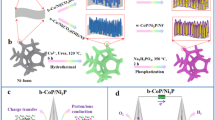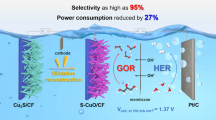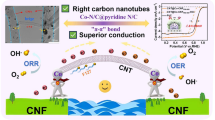Abstract
The rational design and synthesis of hierarchically hollow nanostructures with controlled spatial architecture and composition are significant in electrocatalysis owing to their abundant active sites and the expedited electron/mass transfer. Electrocatalytic nitrate reduction to ammonia is of great interest from the points of environmental protection and energy saving. However, the development of this technology is hindered by the lack of efficient nitrate-to-ammonia electrocatalysts and the kinetically sluggish oxygen evolution reaction at the anode. Herein, a novel self-template conversion method was developed for the synthesis of Co3 O4@NiO hierarchical nanotubes (Co3O4@NiO HNTs) with NiO porous nanosheets assembled on Co3O4 nanotubes. The as-obtained Co3O4@NiO HNTs exhibited an outstanding performance for both the cathodic nitrate electroreduction to ammonia reaction and the anodic tetrahydroisoquinolines (THIQs) semi-dehydrogenation to dihydroisoquinolines (DHIQs). Importantly, a two-electrode system of Co3O4@NiO HNTs ∥ Co3O4@NiO HNTs was constructed for the simultaneous synthesis of ammonia and DHIQs with high selectivity and robust stability.
摘要
等级中空结构的纳米材料具有丰富的活性位点和畅通的电 子/物质传递通道, 因此在电催化领域具有广阔的应用前景. 从环保 和节能的角度考虑, 电催化硝酸根还原合成铵具有重要意义. 高效 电催化剂短缺, 以及动力学缓慢的阳极析氧反应, 严重限制了该技 术的发展. 本论文发展了一种新颖的自模板转化法, 将无机有机杂 化的钴基纳米棒成功转化为Co3O4纳米管@NiO多孔纳米片等级材 料. 该材料在阴极硝酸根电还原为铵和阳极四氢异喹啉类半脱氢 为二氢异喹啉类物质的反应中均表现出了优异的性能. 更重要的 是, 合成的Co3O4@NiO等级纳米管还可作为双功能电极, 同时合成 铵和二氢异喹啉化合物, 并具有良好的的选择性和稳定性.
Similar content being viewed by others
References
Wang X, Feng J, Bai Y, et al. Synthesis, properties, and applications of hollow micro-/nanostructures. Chem Rev, 2016, 116: 10983–11060
Wang Z, Jia W, Jiang M, et al. One-step accurate synthesis of shell controllable CoFe2O4 hollow microspheres as high-performance electrode materials in supercapacitor. Nano Res, 2016, 9: 2026–2033
Jia B, Zhao W, Sun D, et al. Robust anion exchange realized in crystalline metal cyanamide nanoparticles. Chem Mater, 2019, 31: 9532–9539
Steimle BC, Fenton JL, Schaak RE. Rational construction of a scalable heterostructured nanorod megalibrary. Science, 2020, 367: 418–424
Nosheen F, Zhang Z, Xiang G, et al. Three-dimensional hierarchical Pt-Cu superstructures. Nano Res, 2015, 8: 832–838
Agarwal R, Zakharov DN, Krook NM, et al. Real-time observation of morphological transformations in II-VI semiconducting nanobelts via environmental transmission electron microscopy. Nano Lett, 2015, 15: 3303–3308
Li S, Li A, Zhang R, et al. Hierarchical porous metal ferrite ball-inball hollow spheres: General synthesis, formation mechanism, and high performance as anode materials for Li-ion batteries. Nano Res, 2014, 7: 1116–1127
Wu Y, Wang D, Li Y. Understanding of the major reactions in solution synthesis of functional nanomaterials. Sci China Mater, 2016, 59: 938–996
Wu XJ, Chen J, Tan C, et al. Controlled growth of high-density CdS and CdSe nanorod arrays on selective facets of two-dimensional semiconductor nanoplates. Nat Chem, 2016, 8: 470–475
Sun J, Lv C, Lv F, et al. Tuning the shell number of multishelled metal oxide hollow fibers for optimized lithium-ion storage. ACS Nano, 2017, 11: 6186–6193
Zhang B, Jung Y, Chung HS, et al. Nanowire transformation by size-dependent cation exchange reactions. Nano Lett, 2010, 10: 149–155
Li X, Ji M, Li H, et al. Cation/anion exchange reactions toward the syntheses of upgraded nanostructures: Principles and applications. Matter, 2020, 2: 554–586
Joshi RK, Schneider JJ. Assembly of one dimensional inorganic nanostructures into functional 2D and 3D architectures. Synthesis, arrangement and functionality. Chem Soc Rev, 2012, 41: 5285–5312
Yin Y, Rioux RM, Erdonmez CK, et al. Formation of hollow nanocrystals through the nanoscale kirkendall effect. Science, 2004, 304: 711–714
Agarwal R, Krook NM, Ren ML, et al. Anion exchange in II-VI semiconducting nanostructures via atomic templating. Nano Lett, 2018, 18: 1620–1627
Miszta K, de Graaf J, Bertoni G, et al. Hierarchical self-assembly of suspended branched colloidal nanocrystals into superlattice structures. Nat Mater, 2011, 10: 872–876
Li Y, Liu B, Wang H, et al. Co3O4 nanosheet-built hollow dodecahedrons via a two-step self-templated method and their multifunctional applications. Sci China Mater, 2018, 61: 1575–1586
Lu XF, Yu L, Lou XWD. Highly crystalline Ni-doped FeP/carbon hollow nanorods as all-pH efficient and durable hydrogen evolving electrocatalysts. Sci Adv, 2019, 5: eaav6009
He T, Wang W, Yang X, et al. Inflating hollow nanocrystals through a repeated kirkendall cavitation process. Nat Commun, 2017, 8: 1261
Ye X, Jones MR, Frechette LB, et al. Single-particle mapping of nonequilibrium nanocrystal transformations. Science, 2016, 354: 874–877
Duca M, Koper MTM. Powering denitrification: The perspectives of electrocatalytic nitrate reduction. Energy Environ Sci, 2012, 5: 9726–9742
Duca M, Sacré N, Wang A, et al. Enhanced electrocatalytic nitrate reduction by preferentially-oriented (100) PtRh and PtIr alloys: The hidden treasures of the ‘miscibility gap’. Appl Catal B-Environ, 2018, 221: 86–96
Wang Y, Zou Y, Tao L, et al. Rational design of three-phase interfaces for electrocatalysis. Nano Res, 2019, 12: 2055–2066
Zhang JY, Wang H, Tian Y, et al. Anodic hydrazine oxidation assists energy-efficient hydrogen evolution over a bifunctional cobalt perselenide nanosheet electrode. Angew Chem Int Ed, 2018, 57: 7649–7653
You B, Liu X, Jiang N, et al. A general strategy for decoupled hydrogen production from water splitting by integrating oxidative biomass valorization. J Am Chem Soc, 2016, 138: 13639–13646
Zhang JY, He T, Wang M, et al. Energy-saving hydrogen production coupling urea oxidation over a bifunctional nickel-molybdenum nanotube array. Nano Energy, 2019, 60: 894–902
Chaumontet M, Piccardi R, Baudoin O. Synthesis of 3,4-dihy-droisoquinolines by a C(sp3)H activation/electrocyclization strategy: Total synthesis of coralydine. Angew Chem Int Ed, 2009, 48: 179–182
Kato S, Saga Y, Kojima M, et al. Hybrid catalysis enabling room-temperature hydrogen gas release from N-heterocycles and tetrahydronaphthalenes. J Am Chem Soc, 2017, 139: 2204–2207
Huang C, Huang Y, Liu C, et al. Integrating hydrogen production with aqueous selective semi-dehydrogenation of tetrahydroisoquinolines over a Ni2P bifunctional electrode. Angew Chem Int Ed, 2019, 58: 12014–12017
Wang H, Zhuo S, Liang Y, et al. General self-template synthesis of transition-metal oxide and chalcogenide mesoporous nanotubes with enhanced electrochemical performances. Angew Chem Int Ed, 2016, 55: 9055–9059
Shen L, Yu L, Wu HB, et al. Formation of nickel cobalt sulfide ballin-ball hollow spheres with enhanced electrochemical pseudocapacitive properties. Nat Commun, 2015, 6: 6694
Li C, Yin X, Chen L, et al. Synthesis of cobalt ion-based coordination polymer nanowires and their conversion into porous Co3O4 nanowires with good lithium storage properties. Chem Eur J, 2010, 16: 5215–5221
Son DH, Hughes SM, Yin Y, et al. Cation exchange reactions in ionic nanocrystals. Science, 2004, 306: 1009–1012
De Trizio L, Manna L. Forging colloidal nanostructures via cation exchange reactions. Chem Rev, 2016, 116: 10852–10887
Liu Y, Goebl J, Yin Y. Templated synthesis of nanostructured materials. Chem Soc Rev, 2013, 42: 2610–2653
Wang Y, Yu Y, Jia R, et al. Electrochemical synthesis of nitric acid from air and ammonia through waste utilization. Natl Sci Rev, 2019, 6: 730–738
Clesceri LS, Eaton AD, Greenberg AE, et al. Standard Methods for the Examination of Water and Wastewater. American Public Health Association, 1998
Garcia-Segura S, Lanzarini-Lopes M, Hristovski K, et al. Electrocatalytic reduction of nitrate: Fundamentals to full-scale water treatment applications. Appl Catal B-Environ, 2018, 236: 546–568
Sun H, Xu X, Yan Z, et al. Porous multishelled Ni2P hollow microspheres as an active electrocatalyst for hydrogen and oxygen evolution. Chem Mater, 2017, 29: 8539–8547
Dietz RE, Parisot GI, Meixner AE. Infrared absorption and Raman scattering by two-magnon processes in NiO. Phys Rev B, 1971, 4: 2302–2310
Hadjiev VG, Iliev MN, Vergilov IV. The Raman spectra of Co3O4. J Phys C-Solid State Phys, 1988, 21: L199–L201
Wu Y, Yi H, Lei A. Electrochemical acceptorless dehydrogenation of N-heterocycles utilizing tempo as organo-electrocatalyst. ACS Catal, 2018, 8: 1192–1196
Qian XY, Li SQ, Song J, et al. Tempo-catalyzed electrochemical C-H thiolation: Synthesis of benzothiazoles and thiazolopyridines from thioamides. ACS Catal, 2017, 7: 2730–2734
Acknowledgements
This work was financially supported by the National Natural Science Foundation of China (21701122 and 21871206).
Author information
Authors and Affiliations
Contributions
Yu Y and Liu C conceived and directed the project. Wang Y carried out the experiments and wrote the paper. Zhang B revised the paper. All authors contributed to the general discussion.
Corresponding authors
Additional information
Conflict of interest
The authors declare no conflict of interest.
Supplementary information
Experimental details and supporting data are available in the online version of the paper.
Yuting Wang received her BE degree in applied chemistry from Qingdao University of Science and Technology in 2016. She is currently working on her PhD degree at Tianjin University under the supervision of Prof. Bin Zhang. Her research focuses on the development of electrocatalysts for nitrogen cycle reactions.
Cuibo Liu obtained his PhD from Tianjin University in 2015 (supervised by Prof. Bin Zhang). After that, he joined Prof. Kian Ping Loh’s group at the National University of Singapore for his postdoctoral research. He is now an associate professor at Tianjin University. His research interests are mainly focused on photocatalysis, single-atom-catalysis, as well as electrocatalysis by using nanomaterials for selective synthesis of labelled molecules and energy storage.
Yifu Yu received his BE and PhD degrees in chemical engineering from Tianjin University. He carried out postdoctoral research in Nanyang Technological University under the direction of Prof. Hua Zhang (July 2014 to July 2017). Currently, he is a professor in the Department of Chemistry at Tianjin University. His research interests focus on artificial nitrogen cycle.
Supplementary Information
40843_2020_1365_MOESM1_ESM.pdf
Self-template synthesis of hierarchically structured Co3O4@NiO bifunctional electrodes for selective nitrate reduction and tetrahydroisoquinolines semi-dehydrogenation
Rights and permissions
About this article
Cite this article
Wang, Y., Liu, C., Zhang, B. et al. Self-template synthesis of hierarchically structured Co3O4@NiO bifunctional electrodes for selective nitrate reduction and tetrahydroisoquinolines semi-dehydrogenation. Sci. China Mater. 63, 2530–2538 (2020). https://doi.org/10.1007/s40843-020-1365-0
Received:
Accepted:
Published:
Issue Date:
DOI: https://doi.org/10.1007/s40843-020-1365-0




